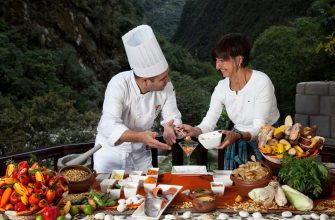A Journey to the Arctic Kitchen
The Arctic, a land of snow and ice, may not be the first place that comes to mind when you think of exciting culinary adventures. However, the far north offers a unique food culture that stands out with its simplicity, authenticity, and a deep connection to nature.
The Foundation of Arctic Cuisine
The core of Arctic cuisine lies in its reliance on locally sourced, often foraged ingredients. The short Arctic summer is a period of abundance, with long daylight hours encouraging growth. During this time, the local flora springs to life, offering a variety of herbs, berries, and mushrooms. These are often collected and preserved to be used during the harsh winter months.
On the other hand, hunting and fishing have always been essential for survival in the Arctic. Caribou, musk ox, seal, and fish, particularly salmon and Arctic char, feature prominently in the Arctic diet. These ingredients are typically prepared in simple but effective ways, such as smoking, drying, or fermenting, that highlight their natural flavors.
The Role of Indigenous Traditions
Indigenous cultures, including the Inuit and the Sami, have significantly shaped Arctic cuisine. These communities have lived in harmony with the harsh Arctic environment for millennia, developing a cuisine that is sustainable, practical, and rich in flavors.
For instance, the Inuit tradition of eating raw seafood is not just a necessity in the frozen north, but also a celebration of the fresh, clean flavors of the Arctic sea. Similarly, the Sami have perfected the art of reindeer herding, and this nutritious, lean meat forms a central part of their diet.
Unforgettable Arctic Dishes
Exploring Arctic cuisine offers a chance to taste some truly unique dishes. One such dish is ‘stinkfish’, a Greenlandic delicacy where fish is fermented in a seal skin bag for several months until it achieves a strong, pungent flavor. Another is ‘suovas’, a Sami dish of smoked reindeer meat often served in a flatbread ‘tunnbröd’ roll with lingonberry jam.
For the sweet tooth, there’s ‘akutaq’, an Alaskan Inuit dessert also known as ‘Eskimo ice cream’. It’s a mix of reindeer fat or fish oil, berries, and sometimes sugar. It may sound unusual, but it’s a treat that highlights the ingenuity of Arctic cooking.
A Lesson in Sustainability
Arctic cuisine offers not just a unique taste experience, but also a lesson in sustainability. It’s a testament to human resilience and ingenuity, demonstrating how to live off the land and sea with respect and gratitude.
The Magic of Arctic Berries
One cannot delve into the Arctic culinary journey without discussing the region’s wild berries. These tiny, brightly colored orbs of sweet-tart flavor become available during the short summer months, providing an essential source of vitamins and antioxidants. The most common types include cloudberries, crowberries, lingonberries, and blueberries. The flavors of these berries are intense and unique, making them a cherished ingredient in jams, desserts, and even savory dishes.
The Seafood Delights
The icy waters of the Arctic are home to a diverse range of sea life, and seafood consequently forms a major part of the Arctic diet. Cod, halibut, salmon, and Arctic char are some of the fish that feature prominently in Arctic dishes. Shellfish, such as clams, mussels, and scallops, are also enjoyed. The traditional Inuit method of preparing seafood often involves drying or fermenting, although modern interpretations also include grilling, frying, and baking.
Arctic Breads and Pastries
Bread plays a significant role in Arctic cuisine. Flatbreads, in particular, are a staple. The Sami ‘gáhkku’ is a soft flatbread that is often wrapped around fillings like smoked reindeer meat. In Greenland, a unique rye bread called ‘qullunaarut’ is made by burying the dough in a wooden box underground, where the geothermal heat slowly bakes it over several hours.
Pastries, too, are popular. Finnish ‘pulla’, a sweet cardamom-spiced bread, is enjoyed at breakfast or with coffee, while the Icelandic ‘kleina’, a kind of fried doughnut, is a beloved treat.
Arctic Beverages
Arctic beverages range from warming drinks to refreshing cold ones. Coffee is deeply ingrained in Arctic culture, particularly in Scandinavian countries, which are among the highest consumers of coffee worldwide. Tea, often brewed with locally foraged herbs, is also common.
For cold drinks, soft drinks made from local berries are popular. In terms of alcoholic beverages, various forms of beer, vodka, and aquavit, often infused with local ingredients, are traditionally enjoyed.
In conclusion, Arctic cuisine is a unique fusion of tradition, nature, and culinary innovation. It’s a testament to the resilience and creativity of the Arctic people, who have managed to create a rich and diverse food culture in a challenging environment. So, if you are looking to embark on a unique culinary journey, the Arctic kitchen is waiting for you with its unique flavors and food experiences.
